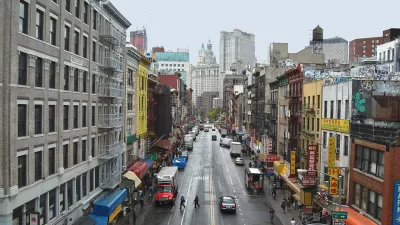A recent study reveals that Los Angeles is the least affordable city in the country. The incentives of homeowners all but ensure that the city will never have a mandate to increase its housing supply and restore health to the city's economy.

Some years ago I spent a day canvassing on behalf of a city council candidate with whom I was friendly. At dusk, I traded my leftover door hangers for an armload of lawn signs. I brought them home and quite pathetically propped one up in the courtyard of my building, next to my front door.
My shortage of lawn was only mildly absurd. What really troubled me, despite my fondness for the candidate, was the message: "Another Family for Flora."
And there you have almost everything you need to know about land use politics in Los Angeles.
*
I didn't exactly qualify as a "family." Like hundreds of thousands of other Angelenos, I lived alone, with occasional flatmates. I routinely equated dinner with Trader Joe's frozen burritos and the inattentive company of Tom Brokaw. I cared about schools only as a general public good and would have welcomed a few more bars, and a few fewer hair salons, in my neighborhood. But what the neighborhood—and all of West Los Angeles really needed—were apartments. Lots of them.
As an editor of The Planning Report, I regularly ran across a harrowing claim: Los Angeles County was short 280,000 housing units. That statistic was propagated, on a nearly weekly basis, by the local Building Industry Association (whose director we interviewed). So, it’s to be taken with some skepticism. But not 280,000 units of skepticism.
This was back in the mid-2000s. Of those two city council candidates, none discussed this shortage and none seemed to eager to promote the production of rental housing. The candidate who won, Bill Rosendahl, championed the preservation of rental stock. Once in office, he supported rent control and legislated against the conversion of rental apartments to condominiums. Rosendahl was avuncular to a fault, and renters were "his people." But, he apparently had all the “people” he needed.
A full ten years later, the residents of Los Angeles—families and otherwise—have even fewer suitable places to rest their heads. That's because city whose politics is dominated by homeowners is often incapable of promoting housing for renters.
*
A UCLA study released this summer contends—probably to the astonishment of baristas in San Francisco and assistants at publishing houses in New York City—that Los Angeles is the least affordable rental market in the country. The study calculates affordability as a function of average incomes, average rents, and the percentage of the former consumed by the latter.
The numbers are enough to make you want to move someplace easier and cheaper. Like, Monaco, Montecito, or Tokyo, maybe. It found the following:
- As of 2013, on average, renters in Los Angeles are paying 47 percent of their income for rent (median rents in the county are $1,473).
- Los Angeles has the highest median rent burden in the nation—at 47 percent.
- Burdens among the bottom quintile have "gone from bad to worse.”
- Los Angeles has relatively fewer publicly subsidized units and weaker rent control.
- Finally, “Los Angeles is the metro area with the largest share of renters vs. homeowners: While U.S. rentership has fluctuated around 35 percent, Los Angeles is at 52 percent.”
Distressingly, the study notes that the extreme rent burden is as much a function of incomes as of housing supply: “Los Angeles has a lower median household income than comparable cities such as New York or San Francisco.” But, make no mistake, housing supply is in crisis every bit as much as wages are.
The study contends, “the city needs to produce roughly 5,300 units per year that are affordable to moderate-incomes or below. Los Angeles has instead averaged roughly 1,100 units per year since 2006.” Those 5,300 annual units square all too well with the 280,000 that we were short countywide seven years ago.
(This week Los Angeles Mayor Eric Garcetti announced an initiative to promote the development of over 100,000 housing units in the city by 2021. This blog was drafted prior to that announcement. We will see how it goes.)
The UCLA study does a lot of data-crunching. It does not, however, try to explain the underlying reasons for this crisis. I don’t blame the authors. It’s a mess.
*
Los Angeles isn't short of housing because of the names on those lawn signs, regardless of who won or lost. The signs don't divide this city. The lawns do.
You don't have to be Howard Zinn to know that homeowners hold political clout in cities. Politicians appeal to homeowners, of detached homes and condos alike, for a few major reasons:
- Stability: They'll be there to vote, year-in, and year-out.
- Engagement: Homeowners know who their public officials are.
- Unity: Homeowners define their interests, and often vote as blocs, because of their homeowners associations.
- Wealth: Duh.
Meanwhile, renters are transient, politically naive, disparate, and, often, poor. In Los Angeles, we're talking about a disastrous constituency that includes, among others, would-be starlets, undocumented immigrants, the chronically poor, and the chronically over-worked. In the March 2012 primary election, Rosendahl’s successor (and former chief of staff) Mike Bonin won with just over 22,000 votes—in a council district with 283,000 residents.
The Los Angeles turnout crisis is making headlines and inspiring studies. One of the findings of the Pat Brown Institute’s 2013 election post-mortem: “Older voters and homeowners are disproportionately represented in mayoral voting.” Imagine how few show up for a mere council seat.
So, the politicians have ever reason to appeal to, and appease, homeowners. But that's just one half of the equation. The other half entails the particular bidding that they are asked to do.
*
In the second half of the 20th century, Los Angeles' single-family homes gave way to small “dingbat” apartment buildings by the thousands, thus creating our awful pattern of high-density living on streets and in neighborhoods that were designed to be suburban. But at least we had housing.
The stucco dried on the last dingbat decades ago. Today, houses get converted to multifamily (usually condos) only where longstanding zoning laws allow it. High-rises that you'd trip over in Sao Paulo or Shanghai draw lavish ribbon-cuttings and excited blog posts here, but that's because they're few and costly.
Typical reasons for opposing high-density housing center on notions of "neighborhood character." Whatever neighbors' particularly concerns are, the message they send to politicians and planners is, “do not upzone. Do not grant that variance. Do not promote the use of density bonuses, and find any loopholes you can to resist them. Parking, parking, parking.”
And then there are scholars, like Joel Kotkin, who promote single-family suburbia and have deemed high densities to be “unbecoming” of Los Angeles. I can think of a lot of things that are a lot more “unbecoming.” Spending every last dime for a roof over my head is one of them.
Whether they like it or not, the politicians and planners comply all too often. How else would you account for such a profound shortage of units, amid rising prices, in a country that considers itself a free-market economy? Especially when rental housing is the hottest typology in the country right now.
Here are a few examples of high-density projects (both for rental and for sale) that have been scuttled or constrained from a few mile radius of where I live:
- A rental building that was supposed to have been 20-plus stories was just completed with eight stories.
- Hundreds of units of housing was quietly proposed for the site of a car dealership, which currently generates plenty of traffic. I haven’t heard a peep from it in months.
- Homeowners groups in Santa Monica have routinely supported policies and even ballot measures to stifle growth, even though much of the city’s traffic comes from workers who drive in from elsewhere because they can’t find housing near their jobs.
Other stories are here, here, here, and an analysis here.
*
Surely, homeowners are entitled to worry about traffic, sight lines, city services, and all the rest. What I suspect, though, is that many homeowners really want to do is what any rational, self-interested actor would want when he or she owns a valuable asset. They want to constrain supply.
Arguments over neighborhood character play well at public hearings. No one will ever admit to being motivated by the crudest manifestation of microeconomics, but here are the facts:
- In a desirable, geographically constrained jurisdiction, the less supply there is, the more valuable each unit becomes.
That's it. Just one fact.
For all the macroeconomic benefits they would bring, the more units renters have to choose from, the less they pay. The less they pay, the less likely they are to ever want to buy a home. The less they want to buy a home, the less each home is worth, on the margin. So, homeowners have every reason to oppose the addition of rental properties. At the very least, they have no incentive to support them.
Homeowners need not worry so much about competition from new for-sale homes. The only new homes in Los Angeles get built on top of, and usually improve upon, old ones. Condos that displace rental units tend to be relatively more expensive, and less dense. And, of course, apartments hold no intrinsic appeal for homeowners, since no one ever wants to trade down.
This pattern is rare on the national level. Plenty of other cities are building like crazy. Most of those cities, like Denver and Houston, enjoy abundant vacant land.
Among its built-out, high-priced peers, New York City is already hyper-dense, so it’s harder to build anything. San Francisco and D.C. are more geographically constrained than Los Angeles is. All three are significantly more dense than Los Angele. Los Angeles has could easily up its game in appropriate places, especially major boulevards and transit corridors, but for this perverse economic rivalry among owners and renters.
*
I wish I knew how to solve this problem.
Public housing and subsidies are crucial, for sure. But they are costly, complex, and solve only a fraction of the problem. This city needs greater supply, period. And it needs it from the source that has always created housing here: private developers. Those developers need to be built responsibly, of course, but they deserve far more support than they’re getting.
If all renters got off the futon and out of the second bedroom, to donate their tip money to candidates who served their interest and to cast their votes accordingly, our city would look radically different. And for the better. People who rent apartments aren't setting up drug empires or plotting to abduct children. They want to work. They want to get a beer. They want to buy stuff at stores down the block and fall in love with the girl or guy around the corner.
They just don't want to buy your house. But your house is gong to be just fine. What's not fine: four people in a two-bedroom apartment, each paying half a month's wages for a bed. Imagine how Los Angeles would prosper if even a fraction of that 47 percent rent burden was liberated to be spent on other things.
That's why if everyone in Los Angeles had a decent place to live, those home values would still do all right. If a city economy does well and all residents prosper, some of those residents might make enough money to—guess what?—buy houses. We just have to see cities as the vast, amazing entities that they are, and not enemy territories that start just the other side of a homeowner’s property line. That’s the message of that UCLA study.
Now is as good a time as any to acknowledge this truth—and to start working toward a grander vision of how we live and prosper in Los Angeles. I don’t mind it when a cranky homeowner tells some kids to get off his lawn. But I do mind it when that same homeowner would, however unwittingly, deny them—singles and families alike—decent places to live.
We need hundreds of thousands of units. And, anyway, we're in a drought. There’s never been a better time to stop caring so much about our lawns and start caring more about each other.

Planetizen Federal Action Tracker
A weekly monitor of how Trump’s orders and actions are impacting planners and planning in America.

Map: Where Senate Republicans Want to Sell Your Public Lands
For public land advocates, the Senate Republicans’ proposal to sell millions of acres of public land in the West is “the biggest fight of their careers.”

Restaurant Patios Were a Pandemic Win — Why Were They so Hard to Keep?
Social distancing requirements and changes in travel patterns prompted cities to pilot new uses for street and sidewalk space. Then it got complicated.

Platform Pilsner: Vancouver Transit Agency Releases... a Beer?
TransLink will receive a portion of every sale of the four-pack.

Toronto Weighs Cheaper Transit, Parking Hikes for Major Events
Special event rates would take effect during large festivals, sports games and concerts to ‘discourage driving, manage congestion and free up space for transit.”

Berlin to Consider Car-Free Zone Larger Than Manhattan
The area bound by the 22-mile Ringbahn would still allow 12 uses of a private automobile per year per person, and several other exemptions.
Urban Design for Planners 1: Software Tools
This six-course series explores essential urban design concepts using open source software and equips planners with the tools they need to participate fully in the urban design process.
Planning for Universal Design
Learn the tools for implementing Universal Design in planning regulations.
Heyer Gruel & Associates PA
JM Goldson LLC
Custer County Colorado
City of Camden Redevelopment Agency
City of Astoria
Transportation Research & Education Center (TREC) at Portland State University
Camden Redevelopment Agency
City of Claremont
Municipality of Princeton (NJ)






























